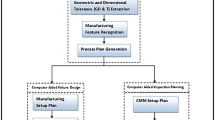Abstract
In metal mold production systems, rapid, high-quality, and low-cost production technologies are needed. In these systems, assembly tasks to make fixtures to immobilize the mold are required. The mold must be firmly fixed in order to resist the force generated by NC machine tools. In this article, we discuss the automatic generation of an assembly process for modular fixture parts in the systems. The assembly drawing of the parts can be obtained from STEP/AP203, which is a text file of CAD/CAF data. In these data, the shape and configuration of all assembled fixtures are included. The shape of each fixture is constructed with planar, cylindrical, and conical surfaces. From the data, the number of surfaces in contact with other surfaces is derived for each part, and valid contacts are judged for their degree of importance. A tree of contacts among all fixtures is derived. In the numerical examples, the assembly process is automatically generated by our proposed method. It is shown that a suitable assembly process is obtained.
Similar content being viewed by others
Explore related subjects
Discover the latest articles, news and stories from top researchers in related subjects.References
Yamada T, Koishikura T, Mizuno Y, et al (2001) Stability analysis of 3D grasps by a multifingered hand. Proceedings of the IEEE ICRA2001, Korea, pp 2466–2473
Yamada T, Ooba T, Yamamoto T, et al (2005) Grasp stability analysis of two objects in two dimensions. Proceedings of the IEEE ICRA2005, Spain, pp 772–777
Mouri T, Yamada T, Mimura N, et al (1999) Identification of contact conditions from contaminated data of contact moment. Proceedings of the IEEE ICRA1999, USA, pp 585–591
Yamada T, Mouri T, Shimosaka K, et al (2009) Uncertainty of estimated parameters of contact conditions by active force sensing. Proceedings of the IEEE ROBIO2008, Thailand, pp 1291–1297
Babu BS, Valli PM, Kumar AVVA, et al (2005) Automatic modular fixture generation in computer-aided process planning systems. Proceedings IMechE, vol. 219, Part C. J Mech Eng Sci pp 1147–1152
Wu Y, Gao S, Chen Z (2008) Automatic modular fixture planning based on linkage mechanism theory. Robotics Comput Integrated Manuf 24:38–49
Ames AL, Calton TL, Jones RE, et al (1995) Lessons learned from a second generation assembly planning system. Proceedings of the IEEE International Symposium on Assembly and Task Planning, USA, pp 41–47
Yi C, Bekey GA (1996) Assembly planning for modular fixtures. Proceedings of the IEEE/RSJ IROS1996, pp 704–711
Author information
Authors and Affiliations
Corresponding author
Additional information
This work was presented in part at the 14th International Symposium on Artificial Life and Robotics, Oita, Japan, February 5–7, 2009
About this article
Cite this article
Yamada, T., Funahashi, Y. & Yamamoto, H. An algorithm for the automatic generation of an assembly process for modular fixture parts. Artif Life Robotics 14, 199–202 (2009). https://doi.org/10.1007/s10015-009-0653-6
Received:
Accepted:
Published:
Issue Date:
DOI: https://doi.org/10.1007/s10015-009-0653-6



